
Questions?
Contact Competition Chair
Julie Lowe at
ejlowe.mom @ gmail.com
PURPOSE: The Redlands Camera Club holds competitions to help our members improve at the art and craft of photography. Preparing an image that will be seen by others and will be critiqued by qualified judges encourages photographers to closely focus on their work so that their very best is presented at the competition. Other organizations have varying rules for competitions. Acceptance into RCC competitions does not guarantee acceptance into others.
ENTRY CLASSES: Members compete against other members of like skill levels, called “Entry Classes.” RCC Entry Classes are Apprentice, Intermediate, and Advanced, and are assigned by members to themselves when submitting images for competition. Members who regularly excel in their particular class should consider moving to a higher class to compete with other members of a more similar skill level. Ribbons are awarded in each category by entry class.
CATEGORIES: Categories are assigned by the entrant, but may be changed by the competition chair if obviously erroneous. Categories are People, Places, Animals, Close-up, Photojournalism, Open/Miscellaneous, and Special (Sometimes called Category X).In every category but Photojournalism (see that category for specific limitations) images may be edited to realize the maker’s vision. Editing can include, but is not limited to, brightness, contrast, tone, color, cropping, removing distracting elements, compositing two or more images (each of which must be made by the entrant), saturation (including conversion to monochrome), sharpening and/or blurring elements of or the entire image, painterly effects, the use of filters, high dynamic range (HDR), stitched panoramas, focus stacking and/or special effects as desired by the maker.
- PEOPLE: Images where the center of interest is a person or persons. They may be formal or casual portraits, posed or un-posed, with or without action.
- PLACES: Images where the center of interest derives from the place at which it was shot. Places include but are not limited to, landscapes, seascapes, cityscapes, and most nature images whose main center of interest is not an animal.
- ANIMALS: Images where the center of interest is one or more animals, wild and/or domesticated. They may be pets, farm animals, residents of a zoo or aquarium, or creatures in the wild or in bodies of water.
- CLOSE-UP: An image shot to emphasize detail, usually at actual-size or greater.
- PHOTOJOURNALISM: Images captured for the purpose of documenting a story. For example, Photojournalism images may include sports, human interactions, events, first-responders in action, and other newsworthy occurrences. Photojournalism images may be converted to monochrome, cropped, and moderately adjusted for contrast, tone, color, or exposure. As the emphasis is on the image captured in the camera, substantial alterations in post-processing editing such as intentional blurring of backgrounds, deletion of distracting elements, or addition of elements that were not in the original capture are not permitted. Additionally, “staged images” or cropping that misrepresents the actual story is not allowed. Composites showing a sequence of multiple exposures of the same subject captured over a very short period to show action are permitted. Story-telling is the key to photojournalism.
- OPEN/MISCELLANEOUS: This category was created for images whose center of interest will not fit neatly into the other categories. It also includes abstracts and digital artistry where the photographer is spotlighting his or her ability to create a unique piece of art through photographic and/or computer techniques. Images incorrectly entered in Open/Miscellaneous may be moved to the proper category by the competition chair.
- SPECIAL CATEGORY (CATEGORY X): For each competition, a special category may be added with a specific theme or photographic technique as the subject. Past category X have included black & white, abstract, and flight. Category X will be announced approximately two months before the competition.
SCORING: During the competition, entries will be presented to the judges in random order. Names of entrants and entry class are not announced to the judges. Images that display the creator’s name or any identifying information such as a watermark or digital signature will be disqualified. The category and title of each entry will be announced and each judge will assign a score as the entry is shown. Rounded scores calculated by the scoring device will be announced. Scoring will be:
Exceptional 95-99
Outstanding 90-94
Excellent 85-89
Above Average 80-84
Average 75-79
Below Average<75
Click Here to read more about the Competition Judging Process
AWARDS: Awards will be based on a numerical average of the judges’ scores calculated to two decimal places by the competition chair. Ribbons for first, second, third, and honourable mention are awarded to the top scorers for each category in each entry class. Best of show will be awarded to the highest-scoring image in the competition, regardless of entry class or category.
Image Specifications for Competitions:
- Images may not identify the maker (ie. no water marks)
- Save the file as a .JPG (not .png, .tif, .psd or .raw)
- Shrink your photos so the longest dimension is between 2,000-4,000 pixels.
- The total file size must not exceed 3.5 MB or file will be rejected.
